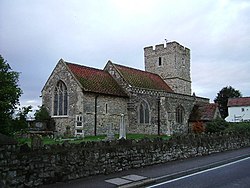Wennington, Essex
| Wennington | |
| Essex | |
|---|---|
 Church of St Mary and St Peter | |
| Location | |
| Grid reference: | TQ540809 |
| Location: | 51°30’22"N, -0°13’8"E |
| Data | |
| Population: | 300 |
| Post town: | Rainham |
| Postcode: | RM13 |
| Dialling code: | 01708 |
| Local Government | |
| Council: | Havering |
| Parliamentary constituency: |
Dagenham and Rainham |
Wennington is a small village ancient parish in the Chafford Hundred of Essex, within the Green Belt on the outskirts of the metropolitan conurbation. It is situated just under 15 miles east of Charing Cross.
Geography
The village of Wennington is south-east of Rainham, along Wennington Road (B1335) near the junction of the A13 road and New Road (A1306). It is just over a mile north of the River Thames. It consists of mostly scattered houses and the Wennington Hall farmhouse. The village population is around 300.
History
In 1066 and 1086 Westminster Abbey held Wennington as a manor and 2½ hides. Several pre-Conquest charters mentioned land in Wennington given to the abbey. The most specific, of 1042–4, confirmed to the abbey the burh at Wennington and 4 hides, with the church and land 'at the lea' (perhaps in Aveley), given by Ætsere the swarthy and his wife Ælfgyth. In 1086 it was stated that ½ hide given to the abbey by a free man had been appropriated by Robert Vaizey, a tenant of Robert Gernon. That holding, later called Wennington Enveyse, probably became part of Leventhorpes manor in the 13th century.
Parish church
The parish church, dedicated to SS Mary & Peter stands in Wennington Road. It is a mediæval church, restored in the Victorian era, constructed of rubble with limestone dressings, comprising nave, chancel, aisles, embattled west tower, north porch, and south organ chamber. The oldest part of the church is a 12th-century round-arched doorway, reset in the vestry. Masoned blocks of limestone, exposed in the foundations of the nave when the floor was renewed in 1960, were attributed to the Norman period, or even earlier. The chancel, nave, and south aisle were apparently rebuilt in the early 13th century. In the early 14th century the north aisle was added. Later in the same century the west tower was built and a new roof was put on to the chancel. In the late 15th or early 16th century the chancel arch and the nave roof were rebuilt, and new furniture was added. The furnishings were further improved in the 17th century. Before 1720, and probably c. 1600, the south aisle was demolished, the two-bay arcade was walled up, two Elizabethan-style windows were inserted, and a south doorway, later blocked. Extensive repairs were carried out in the early 18th century. By 1874 the church was shabby and neglected. (fn. 269) Through the efforts of the rector, Nicholas Brady, and under the architectural direction of the Rev. Ernest Geldart, it was restored and enlarged in 1885–6 to accommodate the increasing population. The south aisle was rebuilt on its ancient foundations, with an organ chamber added. New windows were inserted in the chancel. A west gallery of unknown date was removed, and the base of the tower was converted into a vestry. In 1900 the old porch was replaced by a new one of stone, also designed by Geldart.
Wennington is located at the eastern end of the London Riverside section of the Thames Gateway redevelopment zone and is planned to be the site of the London Riverside Conservation Park.
Transport
Nearest stations
- Rainham railway station
- Purfleet railway station
Culture and community
Wennington Rovers Football Club play their home games at Spring Farm Park, Rainham.
Outside links
| ("Wikimedia Commons" has material about Wennington, Essex) |
